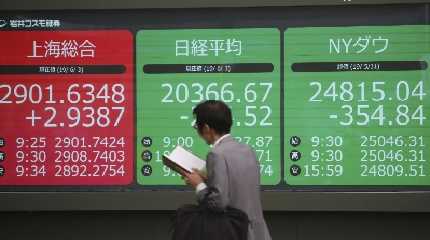
TOKYO (AP) — Asian benchmarks mostly slipped Wednesday as technology shares in the region echoed a similar drop in the sector on Wall Street.
Japan’s benchmark Nikkei 225 inched up 0.1% to finish at 29,332.16. Australia’s S&P/ASX 200 dipped 0.3% to 7,565.80. South Korea’s Kospi dropped 1.3% to 2,950.71. Hong Kong’s Hang Seng shed 1.3% to 22,985.05, while the Shanghai Composite lost 1.0% to 3,596.03.
Worries continue about COVID-19, as reports of the more contagious omicron keep growing in the region.
In Japan, many people are not heeding warnings to take precautions and crowds have been out at levels close to pre-pandemic levels in Tokyo, where booster shots have barely gotten started. Prime Minister Fumio Kishida has promised to speed them up, starting with medical professionals.
“The region may continue to see increasing omicron virus spreads ahead, but recent manufacturing PMIs seem to be holding up for now. The risk may lie in any further restriction measures, which could cloud the services sector outlook, along with disruption to supply chains,” said Yeap Jun Rong, market strategist at IG in Singapore, referring to purchasing manager indexes, an economic indicator on the manufacturing and service sectors.
Analysts expect trading in Asia to stay choppy for some time. Reported daily COVID-19 cases are still small, compared to Europe and the U.S. But the surges are coming quickly, topping 1,000 in Japan recently.
Expert opinion is divided among those who think omicron may set off fewer serious illness and those who advise more caution. Any restrictions on business activity will be sure to weigh on the recovery that all nations are counting on to happen soon.
“Global markets seem to be writing off Omicron as an existential threat, with some suggesting that the Omicron variant represents the ‘last hurrah’ for Covid. Let’s hope they are right. But there may still be a final hit to activity in Asia before we can return to a semblance of normality,” said Robert Carnell, regional head of research Asia-Pacific at ING.
The slide in technology stocks left the S&P 500 slightly lower on Wall Street on Tuesday, even as the Dow Jones Industrial Average marked another all-time high.
The S&P 500 slipped 0.1% to 4,793.54, while the tech-heavy Nasdaq composite fell 1.3% to 15,622.72 after a day of choppy trading. The Dow rose 0.6% to 36,799.65, thanks partly to solid gains by Caterpillar and JPMorgan Chase, which rose 5.4% and 3.8%, respectively.
The Russell 2000 index fell 0.2%, to 2,268.87.
Banks were among the biggest gainers as bond yields rose, pushing the yield on the 10-year Treasury to 1.65% from 1.63% late Monday. The yield was at 1.51% on Friday. When investors sell bonds their prices fall and their yields rise.
Stocks got 2022 off to a good start Monday, with the S&P 500 and Dow setting new highs. A mix of economic data and corporate quarterly earnings reports should give investors some insight into the impact that the coronavirus pandemic and persistently rising inflation are having on companies and consumers.
The job market will be a major focus for investors, starting with the Labor Department’s jobs report for December, which will be released Friday.
Some sectors of the economy are still struggling, especially with supply chain problems. Growth in manufacturing slowed in December to an 11-month low, according to The Institute for Supply Management, a trade group of purchasing managers. The organization will release its December report for the service sector on Thursday.
Investors are also anticipating the minutes from the Federal Reserve’s latest policy meeting in December, set for release on Wednesday.
Walgreens, Constellation Brands and Conagra report their latest quarterly earnings on Thursday.
In energy trading, U.S. benchmark crude fell 8 cents to $76.91 a barrel in electronic trading on the New York Mercantile Exchange. It gained 91 cents to $76.99 a barrel on Tuesday. Brent crude, the international standard, fell 6 cents to $79.94 a barrel.
In currency trading, the U.S. dollar edged down to 116.00 Japanese yen from 116.16 yen. The recent dollar’s range against the yen is at a five-year high, and a cheaper yen can work as a plus for Japan’s giant exporters. The euro cost $1.1299, up from $1.1286.




